Daves Old Computers - Commodore PET
PET = Personal Electronic Transactor
The PET was designed by Chuck Peddle, who was also one of the main
designers of the 6502 processor on which it is based.
Click any photo to view a large high-resolution image.
Commodore PET 2001
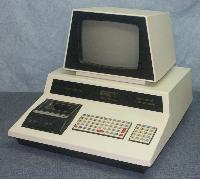 This is the first Commodore PET model ever produced. It is unique with
it's "chicklet" keyboard and built in tape drive. Like all early PET's,
it features a small 9" integrated monitor. This was the first commercial
"all in one" personal computer which you could simply plug-in and begin
using.
This is the first Commodore PET model ever produced. It is unique with
it's "chicklet" keyboard and built in tape drive. Like all early PET's,
it features a small 9" integrated monitor. This was the first commercial
"all in one" personal computer which you could simply plug-in and begin
using.
Here is a view from the back.
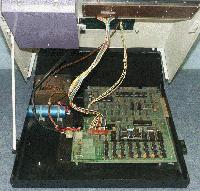 Inside the PET 2001. Note the "cage" containing the integrated tape
drive. All PETs open like a car hood, and even have a "stick" to hold
it open.
Inside the PET 2001. Note the "cage" containing the integrated tape
drive. All PETs open like a car hood, and even have a "stick" to hold
it open.
This was at one time my "spare" PET. It was dead when I got it, and by
swapping parts with my working PET, I determined that it had a bad ROM
chip - unable to obtain (or program) a compatible EPROM, I built a the
board which adapts a standard 2716 EPROM. I gave both of my original
PET's away years ago, however this one has returned to me as a donation
from Fred Aker.
Inside another PET 2001: Note the small PCB
sitting on top of the main board - this is ROM upgrade board, which plugs
into one of the original ROM sockets, and obtains additional selects via
a header soldered onto a 74LS154 decoder chip. This unit has been upgraded
to Commodore BASIC 4.0, the last version of PET basic.
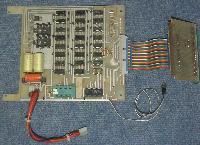 The PET 2001 was initially available in 4k and 8k RAM configurations,
and later a 16k version was produced. The lower RAM versions were quite
limiting, and several companies produced upgrade boards like this 32k
Dynamic Memory board from C.C. Computer Mfg. 32K is the maximum standard
memory allowed by the PET architecture, which reserves the top half of
the 64k address space for ROMs, Video and memory mapped I/O devices.
NOTE the "zero insertion force" socket, which provides a quick and easy
means swap application ROMs.
The PET 2001 was initially available in 4k and 8k RAM configurations,
and later a 16k version was produced. The lower RAM versions were quite
limiting, and several companies produced upgrade boards like this 32k
Dynamic Memory board from C.C. Computer Mfg. 32K is the maximum standard
memory allowed by the PET architecture, which reserves the top half of
the 64k address space for ROMs, Video and memory mapped I/O devices.
NOTE the "zero insertion force" socket, which provides a quick and easy
means swap application ROMs.
 Commodore (a calculator company) thought it was a good idea to put a
calculator style keyboard on their first computer... Some of their
customers didn't, and several companies produced add-on external
keyboards such as the Maxi-Switch unit shown here. It used a special
connector to "Tap" into the internal keyboard connector, allowing
either keyboard to be used. Commodore got the message, and all of
their subsequent computers provided full size keyboards.
Commodore (a calculator company) thought it was a good idea to put a
calculator style keyboard on their first computer... Some of their
customers didn't, and several companies produced add-on external
keyboards such as the Maxi-Switch unit shown here. It used a special
connector to "Tap" into the internal keyboard connector, allowing
either keyboard to be used. Commodore got the message, and all of
their subsequent computers provided full size keyboards.
Commodore PET 2001-N
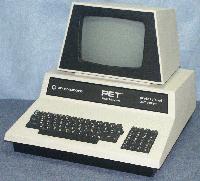 Called the "Professional" version, this next revision PETs most obvious
improvement is that it has a full sized full-travel keyboard.
Called the "Professional" version, this next revision PETs most obvious
improvement is that it has a full sized full-travel keyboard.
Internally, it has a completely redesigned mainboard that can have up
to 32K of dynamic RAM.
Here is a view from the back.
 Inside the CBM 2001-N - Gone is the internal cassette drive, which was
removed to make room for the full sized keyboard.
Inside the CBM 2001-N - Gone is the internal cassette drive, which was
removed to make room for the full sized keyboard.
This is a "type-2" mainboard, which accomodates up to 32k of dymanic
RAM, but still uses the same hard-wired video circutry as the original
PET. The board shown has 32K installed.
Click here to view the inside of an 8K
version of this machine. Note the holes drilled through the board at the
empty RAM location - Commodore did this to prevent upgrading of the
machine. The 8K 2001-N was donated by Brian Saul.
Commodore CBM 2001-B
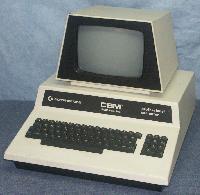 Responding to complaints that the "graphic" keyboard, which had symbols
in the top row (normally numbers) was hard for professional typists to
use, Commodore created a variant of the PET called CBM (Commodore Business
Machines). These machines feature a full typewriter layout keyboard, with
a modified "edit" ROM to handle it, but are otherwise identical to their
PET counterparts.
Responding to complaints that the "graphic" keyboard, which had symbols
in the top row (normally numbers) was hard for professional typists to
use, Commodore created a variant of the PET called CBM (Commodore Business
Machines). These machines feature a full typewriter layout keyboard, with
a modified "edit" ROM to handle it, but are otherwise identical to their
PET counterparts.
Here is a view from the back (note that
the label still says "PET").
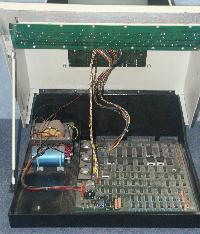 Inside the CBM 2001-B - This uses the same "type-2" mainboard as the
2001-N above.
Inside the CBM 2001-B - This uses the same "type-2" mainboard as the
2001-N above.
This is the only PET model I've seen which uses a third party keyboard
- in this case a Hitek unit with individual metal-contact keyswitches.
All other PET models use a Commodore manufactured keyboard which consists
of plungers with "conductive rubber" bottoms that connect "fingered" traces
on a PCB when the key is pressed down - This suggests that Commodore may
have been in a bit of a hurry to get the typewriter layout keyboard into
the PET.
Commodore CBM 8032 (Early version)
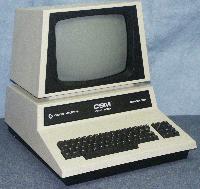 The 8032 (80 Column display, 32k RAM) is the next "Business" PET, marketed
as "CBM". It features a larger 80 column screen, and the typewriter keyboard
which made this machine attractive to professional typists.
The 8032 (80 Column display, 32k RAM) is the next "Business" PET, marketed
as "CBM". It features a larger 80 column screen, and the typewriter keyboard
which made this machine attractive to professional typists.
This machine is a essentially CBM 2001 chassis (note the large label) with
a larger monitor attached. The mainboard has been redesigned (again) to
provide 80 column video, which is accomplished with a 6545 programmable
display controller chip. This allows the display to be switched to a
limited 40 column mode for compatibility with software written for older
machines.
Here is a view from the back.
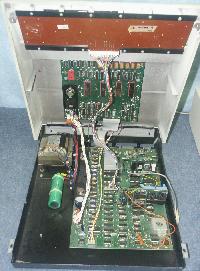 Inside the CBM 8032 - This mainboard is an
"80 column" board used in early 8032s only. Its support for 40 columns
is limited to a partial screen.
Inside the CBM 8032 - This mainboard is an
"80 column" board used in early 8032s only. Its support for 40 columns
is limited to a partial screen.
The 6545 based boards do cause a problem with some older PET software.
The 6545 is mapped at the same address as a control register in previous
"hardware video" designs. It was common practice to write this register to
speed up video access in older PETs, however on the 6545 this sets a bad
refresh rate which can damage the monitor. This is often referred to as
the "Killer POKE", a reference to the BASIC command which activates it.
Donated by Mike Bishop.
Commodore PET 4032
 The PET 4032 (40 column display, 32k RAM) is an upgraded personal/home edition
PET. It retains the "graphic" keyboard layout of the original PET, however it
has the larger display of the 8032 although it only shows 40 columns.
The PET 4032 (40 column display, 32k RAM) is an upgraded personal/home edition
PET. It retains the "graphic" keyboard layout of the original PET, however it
has the larger display of the 8032 although it only shows 40 columns.
Note the shorter chassis (thinner label) which brings the top of the
monitor back to the same height it was on the original 9" PETs.
It uses a new "universal" mainboard, shared with later 8032s and the basis
of all subsequent PETs. This board accomodates up to 32k of RAM, and features
a 6545 CRT controller chip and jumpers to configure the video for 40 or 80
columns.
Here is a view from the back.
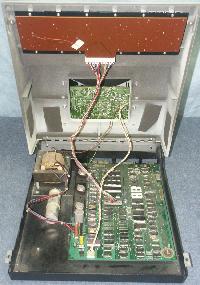 Inside the PET 4032 - This "universal" mainboard is very similar to the
8032 mainboard with only minor circuit changes to allow true 40 column
video. In fact, jumpers are provided to reconfigure the board either way,
and the same board is used on later 8032s. Just below the center of the board
you can see the empty locations where the 80 column video would be
populated in an 8032. Just to the right and slightly above is the jumper
straps which control the video configuration.
Inside the PET 4032 - This "universal" mainboard is very similar to the
8032 mainboard with only minor circuit changes to allow true 40 column
video. In fact, jumpers are provided to reconfigure the board either way,
and the same board is used on later 8032s. Just below the center of the board
you can see the empty locations where the 80 column video would be
populated in an 8032. Just to the right and slightly above is the jumper
straps which control the video configuration.
A 4032 can be upgraded to an 80 column display by adding the missing
RAM & logic chips, changing the "edit" ROM, and reconfiguring the jumpers.
Commodore CBM 8032 (Later version)
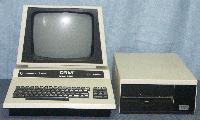 Later versions of the 8032 use the same "universal" mainboard as the 4032,
and also have the shorter chassis which lowers the monitor. This unit is
shown with a Microtech 8" diskette drive system.
Later versions of the 8032 use the same "universal" mainboard as the 4032,
and also have the shorter chassis which lowers the monitor. This unit is
shown with a Microtech 8" diskette drive system.
 Inside this CBM 8032 - as you can see, this unit has had several upgrades.
On the bottom side of the top cover (under the monitor), we can see a Z80
upgrade board which is used to run CP/M.
Inside this CBM 8032 - as you can see, this unit has had several upgrades.
On the bottom side of the top cover (under the monitor), we can see a Z80
upgrade board which is used to run CP/M.
Looking closely at the 8032 mainboard, we
can see two cards have been added. The formost one is a disk controller for
the 8" disk system, and the rearward card is a multi-ROM card.
Note that the boards are plugged into ROM sockets, and have clip leads
running to the various additional signals which are required - this is how
you add cards to a machine with no expansion slots!
Here is a View from the back. Donated by
Markus Wandel.
Commodore SuperPET 9000
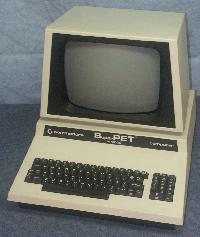 The SuperPET is the ultimate PET. It was co-developed by Commodore
and the University of Waterloo (Canada) and was built around a standard
PET/CBM 8032, with two add-on boards which allowed the system to utilize
a more powerful 6809 processor, and added much more memory.
The SuperPET is the ultimate PET. It was co-developed by Commodore
and the University of Waterloo (Canada) and was built around a standard
PET/CBM 8032, with two add-on boards which allowed the system to utilize
a more powerful 6809 processor, and added much more memory.
This was really designed to be a programmers/engineers machine. It supported
languages such as BASIC, C, PASCAL, FORTRAN, COBOL and even
APL (250k PDF).
Right side view: Note the
switches which select the operating mode/CPU.
Here is a view from the back.
The SuperPET 9000 was donated by Mike Kenzie.
 Here is the interior of the SuperPET 9000 with the 6809 and memory boards
installed. Note the DB-25 connector on the 6809 (middle) board - this provides
a true serial port for uploading and downloading to a host computer - Another
indication that this machine was designed by engineers, for engineers.
Here is the interior of the SuperPET 9000 with the 6809 and memory boards
installed. Note the DB-25 connector on the 6809 (middle) board - this provides
a true serial port for uploading and downloading to a host computer - Another
indication that this machine was designed by engineers, for engineers.
Here is a view with the waterloo boards removed
as you can see, this is a standard 8032 mainboard. Note the risers on the
two expansion ROM sockets with attached switches. These can be switched between
ROM and RAM (clearly a programmers option).
My second SuperPet is a later
series machine which combines all of the Waterloo additions into a
single expansion board. (Donated by Richard Evers)
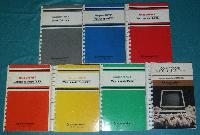 SuperPET System Overview (3.5M PDF)
SuperPET System Overview (3.5M PDF)
SuperPET microAPL (2M PDF)
SuperPET microBASIC (3M PDF)
SuperPET microFORTRAN (2.6M PDF)
SuperPET 6809 Assembler (2.6M PDF)
SuperPET microPASCAL (2M PDF)
SuperPET microCOBOL (6M PDF)
'B' Series
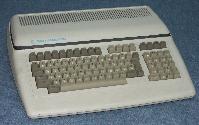 In 1982 Commodore released an updated 'B' series computer based on the PET
design. Intended for 'B'usiness use, this B500 has a lower profile cabinet
and more standard typewriter keyboard. Donated by Ted Evers.
In 1982 Commodore released an updated 'B' series computer based on the PET
design. Intended for 'B'usiness use, this B500 has a lower profile cabinet
and more standard typewriter keyboard. Donated by Ted Evers.
Views:
Front,
Back.
PET Peripherals
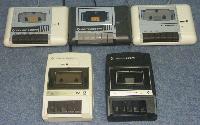 Top: Later VIC/C64 external cassette drives.
Top: Later VIC/C64 external cassette drives.
Bottom: Original PET/VIC external cassette drives.
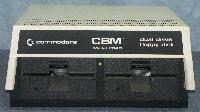 The 2040 disk drive system connects via the IEEE-488 port, and provides
170k of storage per single-sided 5.25" diskette drive. This was basically
the 2020 (first disk system that Commodore offered for the PET series), but
with updated bug-fix ROMs. Here is a view from the
back, and here is is opened up - where you
can see the controller board in the cover, and the two diskette drives in
the base. Note that only the left drive has an interface board, which is
shared with the right drive. Donated by Markus Wandel.
The 2040 disk drive system connects via the IEEE-488 port, and provides
170k of storage per single-sided 5.25" diskette drive. This was basically
the 2020 (first disk system that Commodore offered for the PET series), but
with updated bug-fix ROMs. Here is a view from the
back, and here is is opened up - where you
can see the controller board in the cover, and the two diskette drives in
the base. Note that only the left drive has an interface board, which is
shared with the right drive. Donated by Markus Wandel.
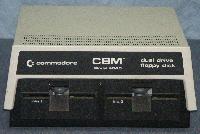 The 4040 disk drive system is physically identical to the 2040 (above),
but has newer more capable firmware (DOS 2). The 4040 also offers 170k
of storage. 2040 drives can be upgraded to 4040 equivalent simply by
installing a new set of ROM.s Here is a view from the
back, and here is is opened up - where you
can see the controller board in the cover, and the two diskette drives in
the base. Note that only the left drive has an interface board, which is
shared with the right drive.
The 4040 disk drive system is physically identical to the 2040 (above),
but has newer more capable firmware (DOS 2). The 4040 also offers 170k
of storage. 2040 drives can be upgraded to 4040 equivalent simply by
installing a new set of ROM.s Here is a view from the
back, and here is is opened up - where you
can see the controller board in the cover, and the two diskette drives in
the base. Note that only the left drive has an interface board, which is
shared with the right drive.
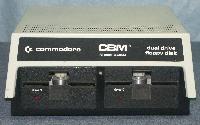 The 8050 disk drive is a higher-end system featuring "quad density"
which provides 512k per diskette side. Here is a view
from the back, and here is is opened up -
where you can see the controller board in the cover, and the two diskette
drives in the base. Note that only the right drive has an interface board,
which is shared with the left drive.
The 8050 disk drive is a higher-end system featuring "quad density"
which provides 512k per diskette side. Here is a view
from the back, and here is is opened up -
where you can see the controller board in the cover, and the two diskette
drives in the base. Note that only the right drive has an interface board,
which is shared with the left drive.
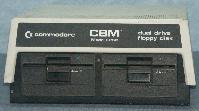 The 8250 is THE commodore drive to have - like the 8050 but double-sided,
providing a whopping 1 megabyte of storage per disk. Here is a
view from the back, and here it is
opened up. Donated by Richard Evers.
The 8250 is THE commodore drive to have - like the 8050 but double-sided,
providing a whopping 1 megabyte of storage per disk. Here is a
view from the back, and here it is
opened up. Donated by Richard Evers.
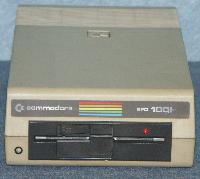 The SFD-1001 is essentially a single-drive version of the 8250, providing
1M of storage. Physically, it looks like the VIC/C64 1541 drive with a PET
compatible IEEE-488 interface instead of the serial bus used on those
machines. Here is a view from the back.
The SFD-1001 is essentially a single-drive version of the 8250, providing
1M of storage. Physically, it looks like the VIC/C64 1541 drive with a PET
compatible IEEE-488 interface instead of the serial bus used on those
machines. Here is a view from the back.
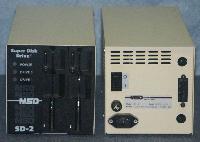 The MSD SD-2 is a third party "clone" of the Commodore 4040 disk drive.
This unit is unique in that it features both the PET IEEE-488 connection,
AND the VIC/C64 1541 serial interface.
The MSD SD-2 is a third party "clone" of the Commodore 4040 disk drive.
This unit is unique in that it features both the PET IEEE-488 connection,
AND the VIC/C64 1541 serial interface.
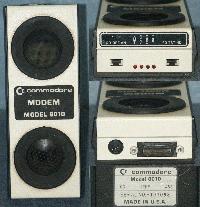 This is a Commodore 8010 300 Bps modem. It is acoustically coupled to
the phone line - you insert the handset of a phone into the rubber "cups",
where a speaker and microphone provide an audio path. This modem is
uniquely PET, because it has an IEEE-488 interface instead of the
usual serial port.
This is a Commodore 8010 300 Bps modem. It is acoustically coupled to
the phone line - you insert the handset of a phone into the rubber "cups",
where a speaker and microphone provide an audio path. This modem is
uniquely PET, because it has an IEEE-488 interface instead of the
usual serial port.
SuperPET advertisement (330k JPG)
Commodore PET User Manual Model 2001-8 (4.3M PDF)
Commodore CBM Users Guide Series 2001 (1M PDF)
Commodore CBM Users Guide Series 8000 (1.5M PDF)
Commodore CBM Users Manual for Dual Floppy Disk Drives (6.8M PDF)
Commodore PET BASIC 4.0 Users Manual (520k PDF)
Commodore PET Frequently Asked Questions (80k TXT)
Commodore PET Memory Map (36k TXT)
Commodore PET Basic Quick Reference (6k TXT)
Commodore C2N Tape Operating Instructions" (1M PDF)
Commodore SuperPET Technical Manual (6M PDF)
Commodore advertisment photo featuring Bill Shatner.
Commodore simulator
6502 CPU Data Sheet (2M PDF)
6809 CPU Data Sheet (2M PDF)
MC6809/E Microprocessor Programming Manual (2.5M PDF)
Mar 1978 BYTE review of PET-2001 (1.4M PDF)
Aug 1982 BYTE review of CBM-8032 (940k PDF)
Back to Old Computers
Copyright 2004-2005 Dave Dunfield.
 This is the first Commodore PET model ever produced. It is unique with
it's "chicklet" keyboard and built in tape drive. Like all early PET's,
it features a small 9" integrated monitor. This was the first commercial
"all in one" personal computer which you could simply plug-in and begin
using.
This is the first Commodore PET model ever produced. It is unique with
it's "chicklet" keyboard and built in tape drive. Like all early PET's,
it features a small 9" integrated monitor. This was the first commercial
"all in one" personal computer which you could simply plug-in and begin
using.






















